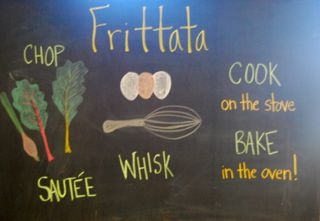Kitchen Humanities: Frittata

Summary
In this 6th grade humanities lesson, students prepare frittata while they review the kitchen systems and skills they have learned during their fall rotation.
Objectives
After this lesson, students will be able to:
- Recognize and name basic tools and equipment
- Recognize correct cooking terms and techniques
- Read and follow a recipe, and understand that some recipes are flexible and some are specific
Assessments
During this lesson, students will:
- Select correct tools and equipment as they prepare frittata
- Use correct cooking terms and techniques in discussion
- Follow the recipe to completion, and suggest adjustments that could be made to the frittata
Materials
For the Chef Meeting
- Frittata recipe
- Ingredients and tools for demonstration
- Visual aid
Tools
- Cast iron skillet
- Grater
- Chef knives
- Paring knives
- Cutting boards
Equipment
- Stove
Ingredients for the Frittata
- Eggs
- Assorted fresh vegetables
- Assorted fresh herbs
- Cheese
- Water
- Salt
- Pepper
- Olive oil
Before You Begin
- Collect all the tools and ingredients, and then distribute them to the tables
- Gather supplies for the Chef Meeting
- Create the visual aid
-
Copy the Frittata recipe to hand out
Procedures
At the Chef Meeting
- Welcome students and introduce the Frittata recipe as an Italian food that can be eaten at breakfast, lunch, or dinner.
- Ask students to think back to Pan de los Muertos, where measuring and following the recipe precisely were important. Discuss the difference between the Pan de Los Muertos recipe and the Frittata recipe. The Frittata recipe offers flexibility, for example: 8-10 eggs, assorted vegetables, etc.
- Refer to the Autumn Harvest Soup recipe and remind students that different vegetables and different parts of the same vegetables cook at different rates. Divide vegetables into two categories, based on how long they take to cook.
- Demonstrate which tool and technique is best for each vegetable; emphasize that the vegetables should be cut into small pieces so they are distributed evenly throughout the dish.
- Ask students to wash their hands and join their table group.
At the Table
- Meet with the table groups to review the recipe and assign jobs.
- Review the knife cuts they learned so far (mince, dice, slice, chop).
- Encourage students to let their senses guide them through the recipe, paying close attention to changes in aroma, color, sound or texture.
- Prepare the recipe and set the table
- Eat.
- Clean up.
- Take the students on a garden walk while the frittata finishes baking in the oven. Point out the different vegetables growing in the garden.
- Discuss with students what kinds of adjustments could be made to the Frittata.
At the Closing Circle
Ask students to share one thing they learned during their fall kitchen rotation.
Vocabulary
Whisk
Sauté
Frittata